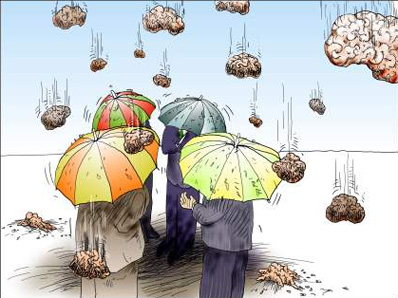資料來源:Positive Psychology News Daily – Chinese 中文(繁)
By Guest Author on December 27, 2010 – 9:30 pm No Comment
黃穎怡 譯
作為向組織介紹積極心理學的顧問,我發現其中一個最容易作為起點的地方是使用強項工具,例如VIA或者 StrengthsFinder 2.0。
在過去的幾年,特別是最近,組織從國際大銀行機構至小型非牟利機構都在研究強項重點的力量。我為員工和管理人員提供為期一天的強項研討會,隨後與領導人會晤,導入強項的重點。
在我上個月對Jeremy McCarthy的 PositivePsychologyNews.com 文章實踐你的強項作出評論後,PPND的編輯要求我提供一些最大限度地利用強項工具的最好辦法。我很清楚你們也有很多偉大的想法,而我很期待閱讀你們的意見。下面是一些建議,我希望對你們匯報 VIA或StrengthsFinder的結果時有用處。(編者注:這也可以用於Realise2 assessment的結果。)
以正面的改變模式開始。你們大多數人可能已經這麼做了。David Cooperrider個人和組織朝著他們集中的方向前進的理論是我研討會的基礎。然後,我將正面的改變模型與缺乏模型作出對比,使人們集中於需要修正的問題。這將員工移往強項的方向,但亦設置了我後來與領導人關於他們組織的談話。
選擇性地使用研究。我熱愛研究。當我剛從MAPP 畢業時,我喜歡告訴所有人積極心理學所有的研究。我學了一個教訓。我選擇性地使用研究。大多數員工都不關心所有的研究,精心挑選的幾個研究已經能夠說明重點。我喜歡用Donald Clifton 常引用的1955年內布拉斯加學校的研究來揭開強項討論的序幕,因為它能引起大多數員工的震驚。這一切都取決於該小組。我提出一些研究,並有更多的準備,假如我需要它們。
於早期討論弱點。對強項工具的其中一個挑戰是大部分人和機構都仍然集中於弱點。忽視弱點或簡單地說假如你專注於強項弱點會自動消失是沒用的。我喜歡Marcus Buckingham的概念,一個人唯一要處理的弱點是他的「氪石」。氪石是能夠妨礙生活或事業的弱點。大多數人都接受這個主意。
指出「什麼」和「如何」強項的分別。今年年初有些人不接受工具確認的強項,他們認為強項是不「真實」的。這些強項並不是人們每天做的事。可是經過一番討論後,他們意識到這些工具指出了他們做事的方法。我現在讓人們寫下並與其他員工討論「什麼」他們做得好,他們的優勢和能力。然後我將「什麼」的強項從「如何」的強項區分出來,就如Peterson 和Seligman 指出的,是我們做事的方式,可應用於不同的任務。指出這些分別能幫助員工根據他們做得很好的任務與他們如何做任務來重新安排一天的時間。
鼓勵人們充分擁有他們的強項。 直至現在,工具得出的結果仍然頗為學術性。由於我研討會上大部分的員工都與他們的朋友坐在一起,我讓他們與朋友分享他們的結果。然後我鼓勵聽者去指出他們在哪兒見過該員工強項的證據。當人們發現別人在自己身上看到這些強項,他們開始真正擁有這些強項。
承認人們對強項的妒忌。我學到不要在組織中比較強項,因為這會形成「擁有」和「沒有」。我以往會作一個誰有什麼強項的表格,但員工會問高層人員有什麼強項,然後去想如何發展這些強項。我現在承認也許他們有些人對強項妒忌,而向他們展示Tom Rath三個擁有完全不同強項的CEO的對比,並提出是他們獨特的長處創造了成功。
使用強項。 員工想知道如何在日常生活中使用他們的長處。根據Buckingham的概念,我讓他們盡量重新設計他們的一天。他們將「什麼」強項放在每天的最佳時間作為充電器,或作為完成艱矩任務的獎勵。然後我讓他們指出如何用「如何」強項令每天或任務更有效率和更愉快。最後,他們或二人一組以另一名員工作出教練,或與他們整個隊伍作一組,看看他們能如何加強自己的強項。
加入強項。 我相信行動計劃。在當天的結束時,參加者訂下個人的行動計劃,明確指出他們會如何發展自己的強項;透過學習、練習和模仿等等,還有他們會如何運用強項。有些領導人收集放於密封信封中的行動計劃,在其後再發還給員工。最後我讓整個小組思考如何提醒大家去專注於及運用強項。
寫這篇文章讓我了解到有很多很好的方法能讓強項評估更有力量。不論你用的是哪個方法,透過在一對一或更大的群體中促進會議的進行,都能為正面的個人和群體改變設置舞台。
編者按:我們加入了Realise2,Alex Linley、Janet Willars,和Robert Biswas-Diener都提及到的強項評估工具,因為以上的方法除VIA和StrengthsFinder外也能用於Realise2。VIA 評估在此,而StrengthsFinder 2.0 也包括在Tom Rath的數本書中,包括參考文獻中提及的書。
參考書目
Buckingham, M (2007). Go Put Your Strengths to Work: 6 Powerful Steps to Achieve Outstanding Performance. NY: Free Press.
Clifton, D. & Harter, J. (2003). Investing in Strengths. In K. Cameron, J. Dutton, & R. Quinn (Eds.), Positive organizational scholarship: Foundations of a new discipline, pp. 111-121. San Francisco: Berrett-Kohler.
Cooperrider, D., Whitney, D. and Stavros,J. (2008). Appreciative Inquiry Handbook, 2nd Edition (Book & CD) . Brunswick, OH: Crown Publishing, Inc.
Linley, P. A., Willars, J. & Biswas-Diener, R. (2010). The Strengths Book: Be Confident, Be Successful, and Enjoy Better Relationships by Realising the Best of You.
Peterson, C. & Seligman, M. (2004). Character strengths and virtues: A handbook and classification. Oxford: Oxford University Press.
Rath, T. & Conchie, B. (2009). Strengths-Based Leadership. New York: Gallup Press.
